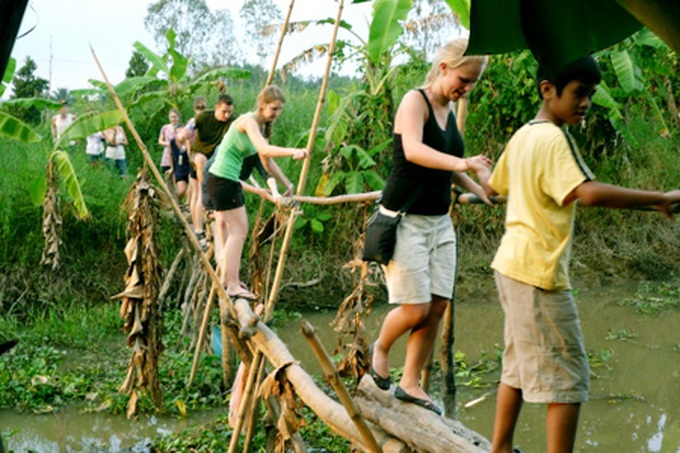 |
| Foreign tourists pass a cau khi, literally translated as monkey bridge - a self-made bridge usually made from bamboos - in Phong Dien District, Can Tho City |
As an eco-tourism area, it attracts people with its fruit gardens and the famous floating market. However, most visitors spend little more than half a day here, going around the gardens, enjoying fruits, and visiting the floating market, before returning to the air-conditioned comfort of their hotel rooms .
We decided to do something different and try a homestay arrangement instead. On a two-day trip where we stayed with two local families and met up with other locals, we ended up enjoying the stay much more than we expected.
Our first homestay was at the house of Lam The Cuong, known locally as Muoi Cuong, on the banks of Ong De Canal, which has been developed into an eco-tourism “road” going through fruit gardens.
From the famous Ninh Kieu Port, we took a boat. After a 40-minute trip, we reached Ong De, got off the boat and walked 100 meters to the house, which is actually a complex of several houses.
The houses not only serve homestay guests, but also Cuong’s big family - his wife, son, daughter, daughter-in-law and grandchildren live together. Thus three generations live under the same roof, something that is difficult to find in Vietnam these days. Our two rooms had entrances to the kitchen and an impressive, large garden.
The first thing we did on arrival was follow Cuong and his family to a cocoa garden for some harvesting and processing experience. We just followed their instructions.
First, they taught us to break the cocoa fruit’s skin and take out its flesh and seeds which can be fermented to make liquor. The flesh and seeds are then dried under the sun and roasted, the pulp is removed and the seeds ground. This powder can be mixed with water for drinking or with other ingredients to make chocolate. The family gave us a homemade bar of chocolate which did not look as good as those sold in shops, but was delicious nevertheless.
Then we enjoyed a surprising cocoa product. Fresh cocoa juice, made by mixing the fruit’s flesh with ice and sugar, makes for a sweet and sour drink that one should not miss if one gets a chance.
During our garden trip, we also picked various vegetables and did some fishing for our dinner.
The dinner was quite simple with rice, a dish of fried noodles with tofu and vegetables, a big bowl of soup cooked with tiny river shrimps, and southern Vietnamese spring rolls with a stuffing of tiny shrimps, pork and sweet potatoes. Simple but delicious, and having the meal sitting in the garden listening to Cuong narrate stories of local life made it special.
The next morning, after breakfast, we hired bicycles and headed for Nguyen Van Xinh’s house, which is located on the Sau Canal next to Ong De.
On the way, we dropped by the garden of Hai, a 70-year-old man famous for producing fruit liquors, especially from ambarella. The entire production process is manual, and Hai claims he can make liquor from any fruit.
Besides buying liquors, visitors can also order wooden furniture since Hai is also a skilled carpenter.
We also visited the house of Mai, who earns a living by cooking and selling tofu, soya bean milk and bánh bông lan (sponge cakes). Though we were too late to see her make the cakes or join in before they were taken to be sold at Phong Dien Market, she generously invited us to try a few of them.
After hanging around for a while, we finally reached Xinh’s house.
Even though we picked vegetables and went fishing again, it was a different experience because the vegetables and fish were different. It was the first time we picked Moringa oleifera leaves from a tree that locals call “chùm ngây,” or magical tree, and had them for dinner. And this time we had red tilapia instead of the giant gourami we had at Cuong’s house.
At night we joined Xinh’s family to catch toads and frogs for making porridge.
The fun did not stop there, but continued the next morning when the family took us to their garden of Burmese grape, locally known as dâu Hạ Châu (Ha Chau grape), Phong Dien’s most famous specialty. We fed turtles and fish, continuing our farmers’ existence for one more day.
A holiday where you do a bit of work, eat healthy, fresh food, learn new things and spend time with the “sons of the soil” – we certainly would highly recommend this to everyone.
THINGS TO KNOW
Contacts:
Nguyen Van Xinh’s homestay service: No.303, Ward 54, Sau Canal, My Khanh Commune, Phong Dien District, Can Tho. Phone: 0710 384 5511 – 097 999 6751
Lam The Cuong’s homestay service: No.275, My Ai Hamlet, My Khanh Commune, Phong Dien District, Can Tho. Phone: 0710 394 2573 – 093 942 7589
Prices:
A room for two people costs VND600,000 (US$28.53) (with air-conditioners) and VND400,000 ($19.02) (with fans). Prices include dinner, breakfast and a night’s stay.
Bicycles can be hired at VND50,000 ($2.37) for half a day and VND100,000 ($4.75) a day.
